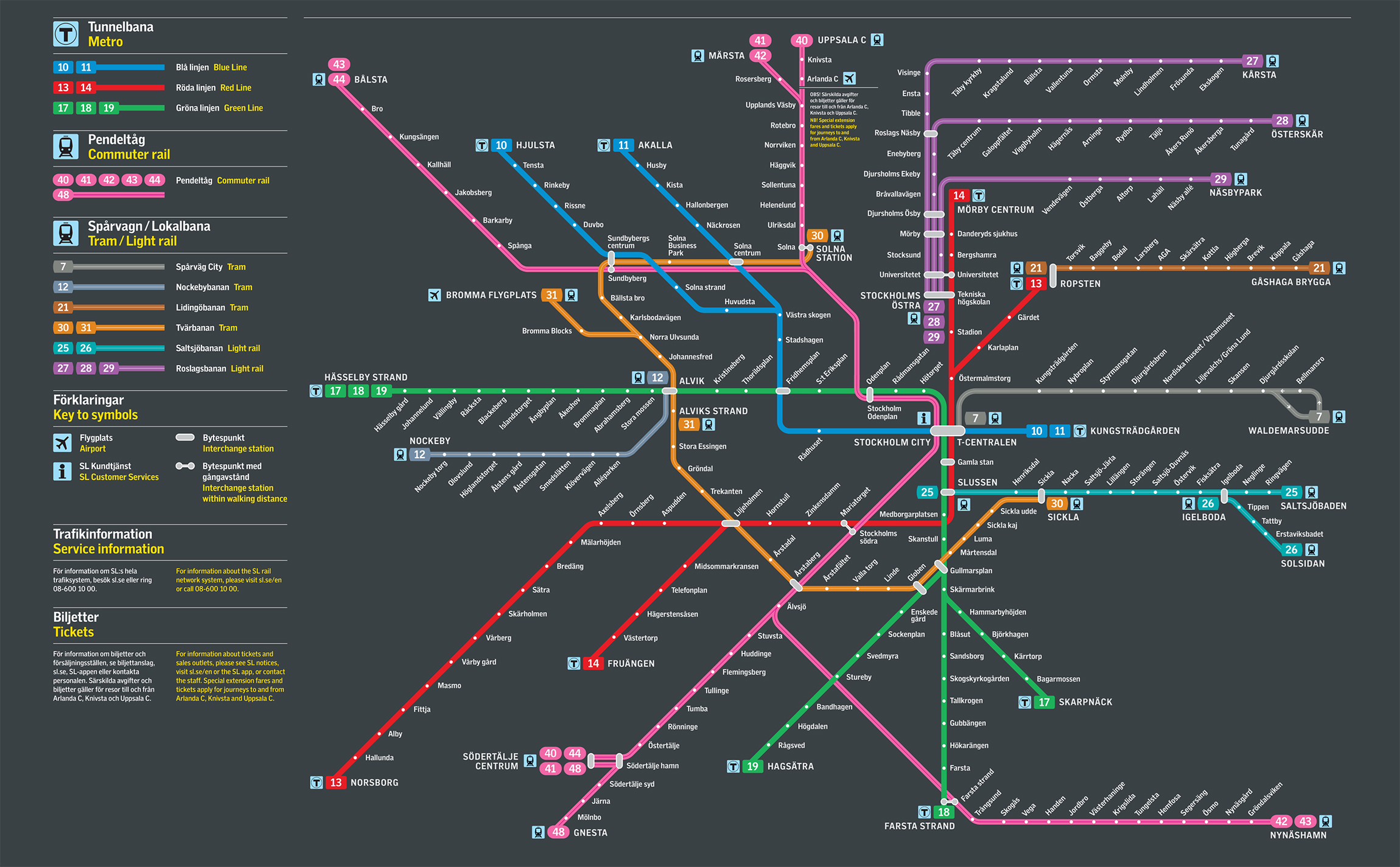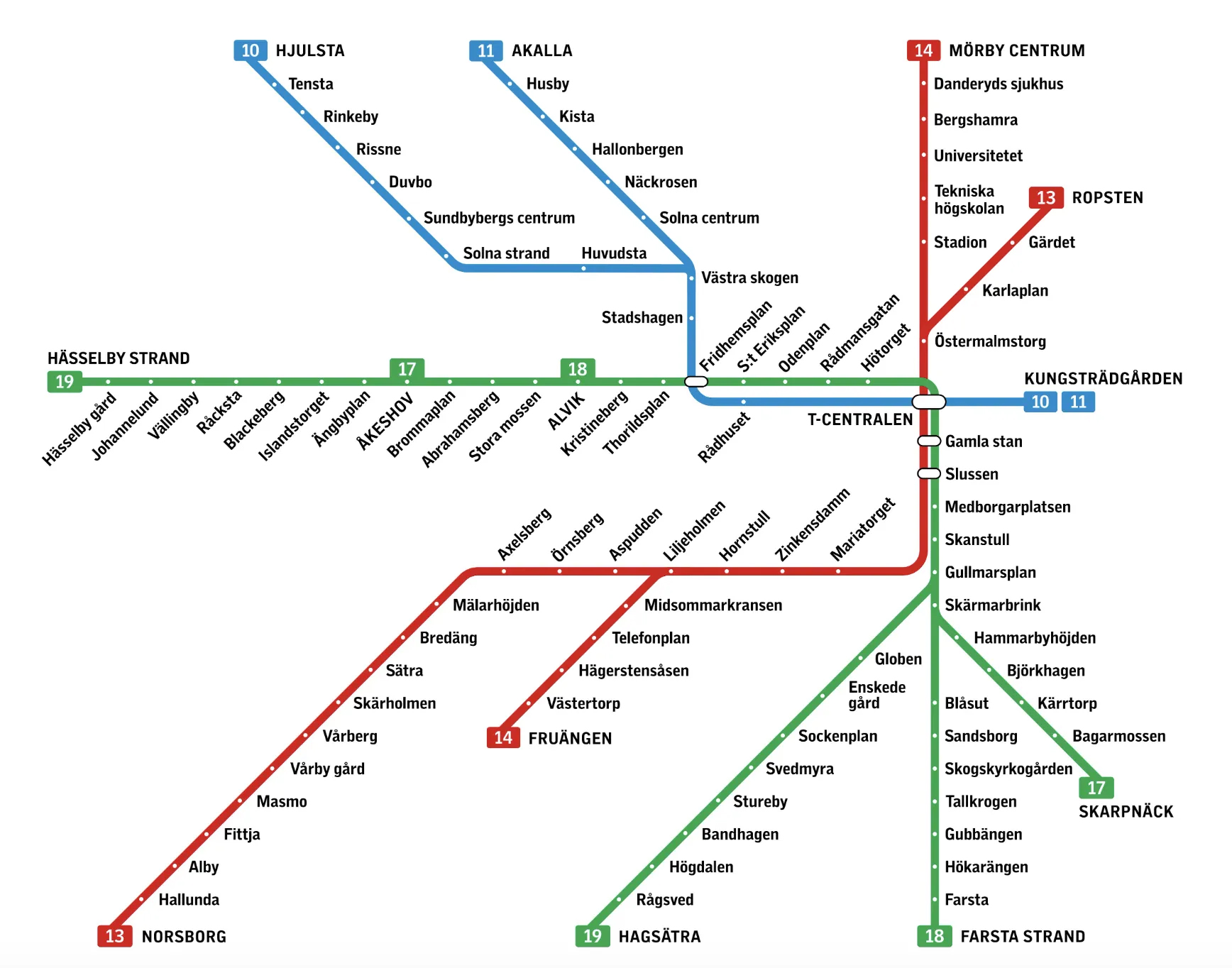Stockholm is often praised by people around the world for its safe, efficient and comfortable transport. The Stockholm Public Transport Agency is responsible for operating the trams, commuter trains, underground trains, buses and some of the ferry lines that operate in the greater Stockholm area. The metro is the easiest way to get around, as the city is divided into three distinct zones. An effective way of exploring the city is to take a tram on route 7 or a bus on route 69. The lines go as far as Djurgarden, with popular tourist attractions such as the Vasa Museum and Skansen on the way.
Public transport system in Stockholm
Cheap and easy to use, Stockholm’s public transport is the preferred means of getting around for most people in the city, including tourists. Let us take a look at the various options the city has to offer when it comes to exploring the region on the local transport network.
Map of Public transport system showing different lines and stations. Click on the map to enlarge it or download the transport system map in PDF format.
Stockholm Metro
One of the most common ways to get around the city is to use the subway system in Stockholm, also known as T-bana or Tunnelbana. Efficient, clean and safe, it is often the preferred mode of transport for people wanting to get from one point to another in and around Stockholm. However, as an underground service, it does not offer visitors the pleasure of being able to admire the city’s various sights during their journey. Service on the central line is fairly frequent, while visitors who want to travel to distant places on the metro service will have to wait around fifteen minutes or more to board a train to their destination.
Map of Stockholm Metro showing different lines and stations. Click on the map to enlarge it or download the Stockholm Metro map in PDF format.
Bus and tram services in Stockholm
Although the maps and timetables of the bus services are rather complicated, it is worth studying them as there are a number of useful connections to many of the suburban tourist attractions. Slussen, Fridhemsplan, Odenplan and Sergels Torg are some of the places from which buses generally depart for inner-city destinations. Some of the bus routes that tourists may find useful are as follows:
- If you need to travel between Djurgarden and Sergels Torg, take tram number 7.
- The best buses for sightseeing in Stockholm are those on route 69. They depart from Sergels Torg and Central stations and go down to Kaknastornet and Ladugardsgardet museums.
- Buses 43 and 65 are very useful for hostellers. The former runs between Sodermalm and Regeringsgatan and the latter between Skeppsholmen and Centralstationen.
Night buses run between one and five in the morning from one of Stockholm’s many central bus stations to the suburbs.
If you need to travel on the Stockholm trams, it is recommended that you take the number 7 tram. Although it may be slower than the bus or metro, there is no better way to explore the city’s various tourist attractions. This route runs between Skansen and Norrmalmstorg, passing by the main attractions on Djurgarden.
Boats or ferry service in Stockholm
One of the most impressive forms of public transport in Stockholm is the boat or ferry service. The one between Djurgarden and Slussen is probably the most attractive for tourists visiting the city, as it covers tourist attractions such as Astrid Lindgren World for children, Grona Lund amusement park and the large island of Skansen, as well as numerous other museums. It also offers a cheap alternative for exploring the water, which is an integral part of the city. Boats also run to Drottningholm Palace, Fjaderholmarna and many other destinations around Stockholm.
Cars and bicycles in Stockholm
Driving in the streets of central Stockholm is not recommended. Limited parking, congested roads and small one-way streets are the main problems in the area. The part of Djurgardsvagen near Skansen is closed at night and on some public holidays and summer weekends. Attempting to drive through Gamla Stan and its narrow streets is unlikely to be successful. There are car parks in the city, but they charge exorbitant rates. If you are interested in driving and have your own car, leave it on the outskirts of Stockholm and take public transport into the city.
On the other hand, Stockholm is a cyclist’s paradise, with an extensive network of cycle paths criss-crossing the city. You can either bring your own bike or rent one from a rental station. Bikes can be taken free of charge on the SL local train network at off-peak times, but are strictly forbidden on the metro. Nevertheless, there are some brave souls who try to do the impossible.
Taxi in Stockholm
Hiring a taxi in Stockholm is not a problem as there are a large number of operators. However, it is essentially a very expensive form of transport. Either negotiate the fare to your destination or agree to a metered fare before you get in. When travelling at night, women can ask for special discounts, as there are many operators who offer this.
How to get around in Stockholm
As Stockholmers pay special attention to their environment and strive to keep it beautiful, the city’s transport system is slowly switching to an environmentally friendly mode. Most of the public buses that run through the city centre are powered by ethanol and similar environmentally friendly fuels. Stockholm’s metro system is also considered the world’s longest art gallery, with works by numerous artists adorning the walls of many of the stations along the network.

